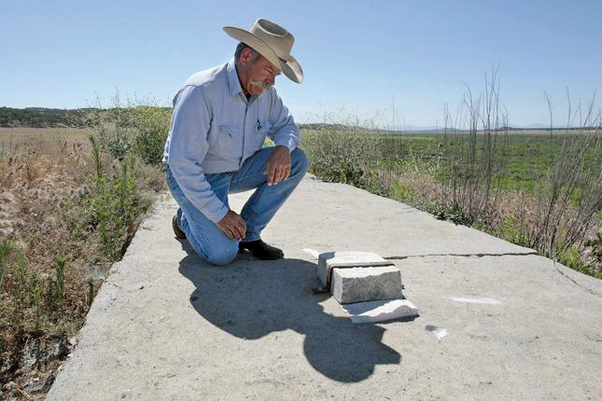BRADLEY, Calif. — Joseph Botts Jr. stepped out of his pickup truck into a scrubby, sunbaked field of salt grass and mustard weed and bent over a granite slab bearing a worn inscription: “Corp’l John McBride.”
The retired park ranger has known about the Civil War veteran’s gravesite for most of his life. But for much of the past half-century, McBride’s remains and the tiny ghost town where he met his fate lay at the bottom of a reservoir, submerged due to a thirsty state’s need to corral every drop that flows through its parched ravines.
Now California’s historic drought has shrunk Monterey County’s Lake San Antonio to a fraction of its former size, exposing McBride’s headstone to sunlight for the first time in decades. The re-emergence of the 128-year-old gravesite has inspired Botts, one of the few locals who even remember it exists, to ensure the veteran’s burial place and his memory are preserved.
“He was probably an unemployed soldier looking for a quiet way of life in a peaceful valley,” Botts said recently while showing off the site.
Shortly before Botts retired from the park service in April, a camper found McBride’s headstone in the desiccated lake bed and delivered it to park headquarters. Botts brought it back to McBride’s gravesite, which he’d remembered from his childhood, and fastened the headstone to it with a metal bracket.
“It was for the honor of who’s resting there,” Botts said. “You don’t screw around with something like that.”
An Irish immigrant, McBride survived the Civil War only to be killed two decades later in an argument on a California ranch. His grave and a few building foundations are all that remain of Pleyto, a rural town that was flooded in 1965 to create the reservoir.
The town, sometimes spelled “Pleito” or “Plato,” was settled in 1868 as a stagecoach stop between Gilroy and Los Angeles. In its heyday in the 1890s, it boasted no more than a few dozen inhabitants, with a single store, hotel, post office and blacksmith shop.
With little commerce besides ranching and farming, the post office closed in 1925, and the town’s residents gradually packed up and left.
“It’s just one of those ephemeral places in the West,” said Ann Beckett, a local historian and co-author of the book “Images of America: San Antonio Valley.” “Making your living there was so grim that the town just went away.”
But McBride’s remains never left. Born in Ireland around 1825, he lived in St. Louis before joining the Union Army in Illinois at the age of 36, according to Civil War records maintained by the Illinois state archives. He served from 1861 until 1864 and fought in a number of major campaigns, including the 1864 Battle of Nashville. Then, he disappeared from history until 1887 — the year of his death.
“They couldn’t make contact with any of the relatives,” said Botts, who grew up on an 8,000-acre ranch adjacent to the burial ground. “So they thought they’d just leave him.”
In the early 1960s, Botts’ school bus would rumble along the dirt road past old Pleyto and across the San Antonio River, now the middle of the lake. When the river flooded, postal workers would transport mail over the water in a hand-cranked cable car.
But Botts’ earliest memories of Pleyto are of nothing but old foundations and a bridge. It was a ghost town long before engineers laid the foundation of the San Antonio Dam.
Park ranger Jon Anthony estimates it’ll take 20 to 25 more feet of water to submerge McBride’s gravesite once more — one rainier-than-average year.
Botts said that wouldn’t trouble him.
“If he’s remembered,” Botts said, “it doesn’t make any difference where he is.”
At that time, according to handwritten court records from that era, McBride — who also went by either John “Marigan” or John “Madigan,” depending on whom you asked — was working as a ranch hand for the developer who settled Pleyto.
He was herding cattle on horseback one March evening when he got into an argument with a neighboring rancher named Henry Godfrey. During the confrontation, McBride reached behind his horse’s saddle — and Godfrey, fearing he was going for a weapon, fired his shotgun at McBride’s chest.
“McBride fell off his horse and said, ‘I’m killed,’” reported one witness.
Authorities never determined if McBride was armed. But Godfrey claimed self-defense and eventually was acquitted of murder charges, according to the records of his trial.
“It’s a tragic story,” said James Perry, a Monterey County historian who unearthed Godfrey’s 65-page trial record in county archives after being asked about the mystery of John McBride.
Still, much about McBride’s life has been lost to the ages. He was discharged from the Union Army at a lower rank — private — than corporal. But Gwen Podeschi with the Abraham Lincoln Presidential Library in Illinois said this wasn’t necessarily a sign of demotion.
“Quite often, these men decide they just don’t want to serve as a corporal anymore,” she said.
She also said it was common for veterans to turn west after the war. Why some said they knew him by other names is a mystery. Perry said it could be a hint of trouble in his past, though he noted it wasn’t uncommon in the 19th century for men to go by different names.
McBride was buried in a knoll by himself, a short distance away from where a handful of townspeople and other Civil War veterans had been buried in the old town cemetery. In the early 1960s, local officials relocated the cemetery to higher ground before filling what would become the Lake San Antonio reservoir in 1965.
But McBride remained.




